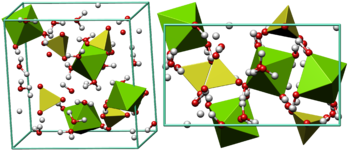Epsomite: Difference between revisions
Cote d'Azur (talk | contribs) No edit summary |
Rescuing 1 sources and tagging 0 as dead. #IABot (v1.6.2) (Balon Greyjoy) |
||
| Line 64: | Line 64: | ||
==References== |
==References== |
||
{{Reflist}} |
{{Reflist}} |
||
*[http://mineral.galleries.com/minerals/sulfates/epsomite/epsomite.htm Mineral galleries] |
*[https://web.archive.org/web/20060317160728/http://mineral.galleries.com/minerals/sulfates/epsomite/epsomite.htm Mineral galleries] |
||
[[Category:Magnesium minerals]] |
[[Category:Magnesium minerals]] |
||
Revision as of 19:33, 22 January 2018
| Epsomite | |
|---|---|
 | |
| General | |
| Category | Sulfate mineral |
| Formula (repeating unit) | MgSO4·7H2O |
| Strunz classification | 7.CB.40 |
| Dana classification | 29.6.11.1 |
| Crystal system | Orthorhombic |
| Crystal class | Disphenoidal (222) H-M symbol: (2 2 2) |
| Space group | P212121 |
| Unit cell | a = 11.86, b = 11.99 c = 6.858 [Å]; Z = 4 |
| Identification | |
| Color | White, grey, colorless, or pink, greenish |
| Crystal habit | Acicular to fibrous encrustations |
| Twinning | Rarely observed on {110} |
| Cleavage | {010} perfect {101} distinct |
| Fracture | Conchoidal |
| Mohs scale hardness | 2 |
| Luster | Vitreous, silky when fibrous |
| Diaphaneity | Transparent to translucent |
| Specific gravity | 1.67 - 1.68 |
| Optical properties | Biaxial (-) |
| Refractive index | nα = 1.433 nβ = 1.455 nγ = 1.461 |
| Birefringence | δ = 0.028 |
| 2V angle | Measured: 52° |
| Solubility | In water |
| Alters to | Dehydrates in dry air |
| References | [1][2][3] |
Epsomite is a hydrous magnesium sulfate mineral with formula MgSO4·7H2O.
Epsomite crystallizes in the orthorhombic system as rarely found acicular or fibrous crystals, the normal form is as massive encrustations. It is colorless to white with tints of yellow, green and pink. The Mohs hardness is 2 to 2.5 and it has a low specific gravity of 1.67.
Epsomite is the same as the household chemical, Epsom salt, and is readily soluble in water. It absorbs water from the air and converts to hexahydrate with the loss of one water molecule and a switch to monoclinic structure.
Discovery and occurrence
Epsomite forms as encrustations or efflorescences on limestone cavern walls and mine timbers and walls, rarely as volcanic fumarole deposits, and as rare beds in evaporite layers. It was first systematically described in 1806 for an occurrence near Epsom, Surrey, England, after which it was named. It occurs in association with melanterite, gypsum, halotrichite, pickeringite, alunogen, rozenite and mirabilite.[3]
Related minerals
The epsomite group includes solid solution series with morenosite (NiSO4·7H2O) and goslarite (ZnSO4·7H2O)[2]
Kieserite (MgSO4·H2O) is a less hydrated magnesium sulfate.

